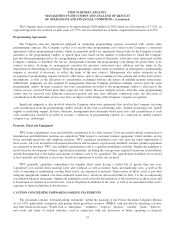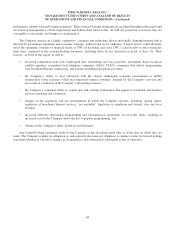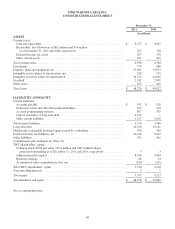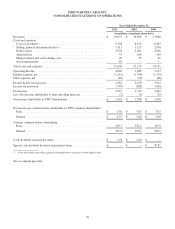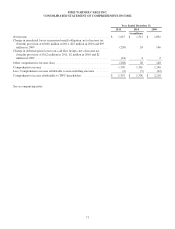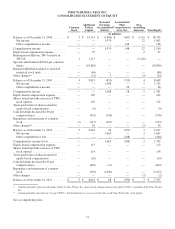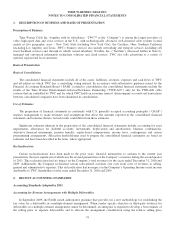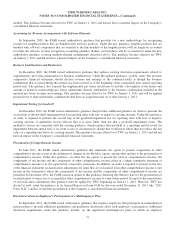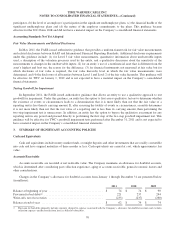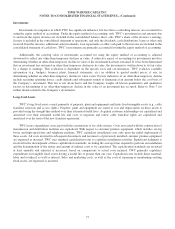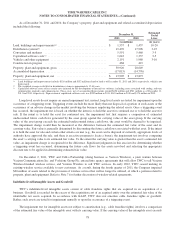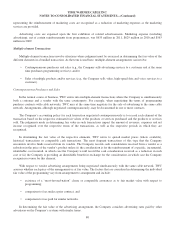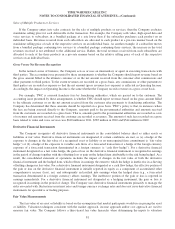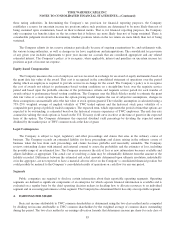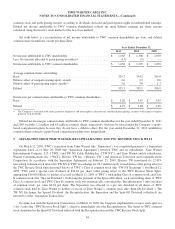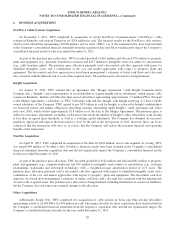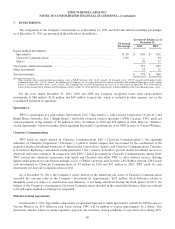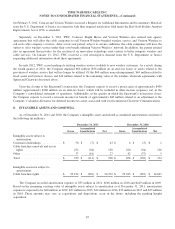Time Warner Cable 2011 Annual Report Download - page 85
Download and view the complete annual report
Please find page 85 of the 2011 Time Warner Cable annual report below. You can navigate through the pages in the report by either clicking on the pages listed below, or by using the keyword search tool below to find specific information within the annual report.TIME WARNER CABLE INC.
NOTES TO CONSOLIDATED FINANCIAL STATEMENTS—(Continued)
Investments
Investments in companies in which TWC has significant influence, but less than a controlling interest, are accounted for
using the equity method of accounting. Under the equity method of accounting, only TWC’s investment in and amounts due
to and from the equity investee are included in the consolidated balance sheet; only TWC’s share of the investee’s earnings
(losses) is included in the consolidated statement of operations; and only the dividends, cash distributions, loans or other cash
received from the investee, additional cash investments, loan repayments or other cash paid to the investee are included in the
consolidated statement of cash flows. TWC’s investments are primarily accounted for using the equity method of accounting.
Additionally, the carrying value of investments accounted for using the equity method of accounting is adjusted
downward to reflect any other-than-temporary declines in value. A subjective aspect of accounting for investments involves
determining whether an other-than-temporary decline in value of the investment has been sustained. If it has been determined
that an investment has sustained an other-than-temporary decline in its value, the investment is written down to its fair value
by a charge to earnings. This evaluation is dependent on the specific facts and circumstances. TWC evaluates available
information (e.g., budgets, business plans, financial statements, etc.) in addition to quoted market prices, if any, in
determining whether an other-than-temporary decline in value exists. Factors indicative of an other-than-temporary decline
include recurring operating losses, credit defaults and subsequent rounds of financing at an amount below the cost basis of
the Company’s investment. This list is not all-inclusive and the Company weighs all known quantitative and qualitative
factors in determining if an other-than-temporary decline in the value of an investment has occurred. Refer to Note 7 for
further details related to the Company’s investments.
Long-lived Assets
TWC’s long-lived assets consist primarily of property, plant and equipment and finite-lived intangible assets (e.g., cable
franchise renewals and access rights). Property, plant and equipment are stated at cost and depreciation on these assets is
provided using the straight-line method over their estimated useful lives. Acquired customer relationships are capitalized and
amortized over their estimated useful life and costs to negotiate and renew cable franchise rights are capitalized and
amortized over the term of the new franchise agreement.
TWC incurs expenditures associated with the construction of its cable systems. Costs associated with the construction of
transmission and distribution facilities are capitalized. With respect to customer premise equipment, which includes set-top
boxes and high-speed data and telephone modems, TWC capitalizes installation costs only upon the initial deployment of
these assets. All costs incurred in subsequent disconnects and reconnects of previously installed customer premise equipment
are expensed as incurred. TWC uses standard capitalization rates to capitalize installation activities. Significant judgment is
involved in the development of these capitalization standards, including the average time required to perform an installation
and the determination of the nature and amount of indirect costs to be capitalized. The capitalization standards are reviewed
at least annually and adjusted, if necessary, based on comparisons to actual costs incurred. TWC generally capitalizes
expenditures for tangible fixed assets having a useful life of greater than one year. Capitalized costs include direct material,
labor and overhead, as well as interest. Sales and marketing costs, as well as the costs of repairing or maintaining existing
fixed assets, are expensed as incurred.
77


